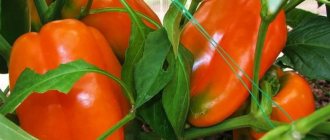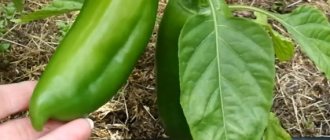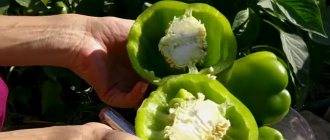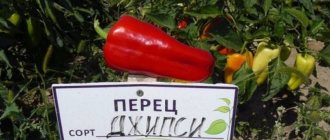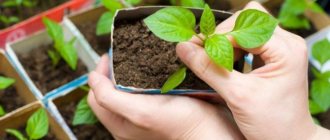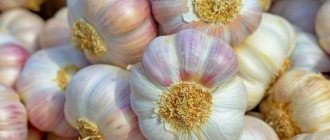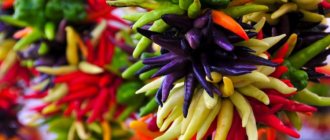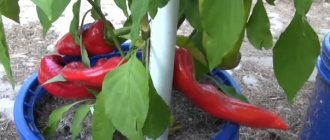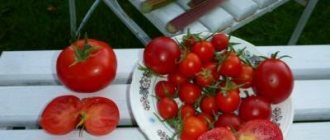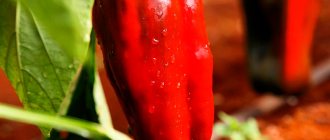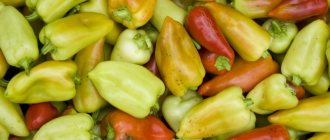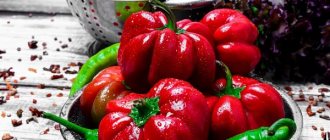Vegetable growing » Pepper
0
523
Article rating
Kira Stoletova
Sweet pepper is a capricious vegetable, and its harvest depends entirely on growing conditions and region. Time does not stand still, and breeders do not stop working, creating new and improved varieties and hybrids that are resistant to temperature fluctuations and can form ovaries in any weather. The Player bell pepper has these properties.
Pepper Growing Player
Pepper Player: reviews, photos, yield
Bell pepper is considered by many novice vegetable growers to be a very capricious vegetable crop, which is extremely difficult to grow not only in the garden, but also in greenhouse conditions. After all, such a vegetable is considered too heat-loving, unable to tolerate even slight cold snaps, the yield of which directly depends on the weather conditions in the region.
All this is true, but recently dozens of new varieties and hybrids of bell peppers have been developed with improved characteristics, resistance to slight cold, forming ovaries in cloudy and rainy weather and producing good harvests.
One of the best early-ripening sweet bell peppers is the Player variety.
. Its other characteristics, advantages and nuances of cultivation will be discussed below.
Pepper Player photo on a bush
History of the variety
The manufacturer of this variety is considered to be an agrotechnical company. When breeding the variety, breeders set themselves the task of obtaining a pepper that would be resistant to adverse weather conditions and temperature changes, the fruits would ripen smoothly, and the yield would be high.
The developed variety Player has all of the above advantages, therefore, after being included in the State Register, this vegetable plant quickly became popular among summer residents from different regions of Russia and was grown in open ground even in regions with a cold climate such as the Urals, Siberia and the Leningrad region.
Pepper Player: characteristics and description of the variety
Pepper Player can be grown in open ground and film greenhouses; its ripening period is early; at least 3.5 months pass from the moment the first shoots appear to the harvest of ripe fruits
.
The bushes are miniature, compact, semi-spreading. The shoots reach a height of 0.45-0.50 m. The foliage is medium in size, slightly wrinkled, dark emerald in color. Due to their miniature size, the plants do not require shaping and tying, despite the large size of the ripening fruits.
NEW!
Sweet pepper LIVADIA F1
The fruits grow downward, their shape is cuboid. Ripe peppers are large, with a slightly ribbed surface, the skin is shiny. At the stage of technical maturity, the color of the fruit is green; as the peppers fully ripen, the color of the peppers becomes deep red. Weight of ripe products – up to 150 g
. The taste is sweet, without bitterness, with a characteristic peppery smell. This pepper has very thick walls - up to 10-12 mm.
The purpose of the harvest is universal; the fruits are stuffed, added to salads and snacks, used for preparing hot dishes, canned, frozen.
The variety is highly resistant to changes in air temperature and unpretentious to growing conditions.
Pepper Yield Player
Pepper Player is responsive to regular watering and fertilizing during the period of fruit growth and ripening. If these conditions are met, then the yield of this vegetable crop will be at least 5.5-6 kg per square.
Important!
In regions with a short summer period, it is recommended to grow this bell pepper in film greenhouses, where its yield will be slightly higher than in open ground.
The release of ripe peppers is friendly, almost simultaneous, which is a big plus for such regions of its cultivation as Siberia or the Urals.
Classification by bush height
Depending on the height of the plant, peppers are divided into:
- tall with a plant height of 90 cm and above;
- medium-sized - bushes from 60 to 90 cm;
- low-growing - bushes up to 60 cm tall.
Tall varieties
There are not very many tall peppers, but among them there are the most popular:
- "Livadia F1" is a hybrid greenhouse mid-season variety with a bush height of about 1.5 meters and large fruits.
- “Sonata F1” - the bush reaches 2 meters in height and requires support.
- "Montero" - with a bush height of about 1.2 m and massive fruits.
- “Novorossiysk” is an early ripening variety with small fruits and a bush of about 1 meter.
Low growing peppers
Varieties of peppers with low bushes are rare, although in small areas they are preferable; moreover, it is in these varieties that you can find different colors of fruits on one bush.
Important! When deciding to choose low-growing pepper varieties, you should pay attention to the fact that they all love good lighting and a lot of bright daylight.
Examples of low varieties of bell peppers are:
- “Little Chanterelle” is an early ripening orange variety that can even be grown on the balcony. Bush height 40 cm.
- “Sveta ” is an early (110 days) yellow pepper, up to 60 cm high. The fruits are classic conical in shape, weighing 60-80 g, with a smooth glossy surface.
- “Fakir” is a high-yielding red vegetable with a compact bush of 50 cm.
- “ Agapovsky” is the earliest low-growing variety, up to 80 cm high. The first peppers are harvested on the 100-110th day. The fruits are dark green, becoming red as they ripen.
- “Ivolga” is a complete analogue of “Agapovsky” with yellow fruits. Ripens 80-100 days after germination.
Growing and caring for sweet peppers Player
In most Russian regions, it is recommended to grow the Player pepper variety in seedlings, and the seeds should be planted for seedlings a couple of months before they are transplanted into beds or a greenhouse. The period for planting seed material of Player pepper is the first ten days of March.
This is useful!
An article about growing peppers in a greenhouse and open ground.
Purchased Player pepper seeds do not require treatment before sowing; it is enough to soak them for germination. It should be remembered that peppers take longer to germinate than tomatoes. The germination rate of seeds of the Player variety is high – up to 95%.
When growing seedlings, you need to remember that pepper seedlings are responsive to regular watering and fertilizing.
Pepper seedlings are planted in open ground when the plants have at least 5 pairs of true leaves. The air temperature at this time should be at least 14-15 degrees Celsius. The approximate time for transplanting seedlings to a permanent place is the second or third decade of May.
When caring for peppers in the garden, you should definitely adhere to a certain watering regime - the soil should not dry out, and watering should not be too abundant so that there is no stagnation of moisture in the soil.
During the growth of these peppers, it is necessary to apply at least 3-4 fertilizing with complex mineral fertilizers. Fertilizers should be applied a couple of weeks after transplanting the seedlings into the beds, before flowering, during the flowering period and during the ripening of fruits.
Pepper variety Player photo
Diseases and pests
The Player variety is highly resistant to most diseases that affect other vegetable crops of the Solanaceae family. It is not affected by pests either.
Growing rules
Denis pepper seedlings are sown in late February or early March. From the moment the seedlings emerge, the seedlings are grown for a month and a half and, in the budding phase, are sent to a permanent planting site.
Important! When hardening the seeds, you must not forget to keep them slightly moist.
Seed selection and preparation
The F1 marking always indicates a hybrid. Thus, there is no point in harvesting seeds from the previous harvest - the characteristics of these plants will not be passed on to the new generation. Each time you need to purchase seed packets from the manufacturer. It is very important to ensure that the seeds are of high quality, free of rot and plaque, and of the same size. Before planting seedlings, they need to be sorted out and low-quality material rejected.
It is also advisable to check the seeds for germination. To do this, you need to select ten pieces, put them in fabric bags and put them in warm water for 24 hours. The seeds, then removed from the water, are placed on a flat plate and placed in a warm place (temperature not lower than +30°C), keeping the bags moist for another 3–4 days. If during this time at least half of the seeds have hatched, then germination will be good.
Depending on the conditions of future planting, the farmer decides whether to disinfect the seeds or not. This can be done in a strong solution of ordinary potassium permanganate, keeping the seeds in it for about half an hour. Hardening of seeds is considered mandatory and involves exposing the seed to variable temperatures for a week.
The seeds are placed in the refrigerator on the bottom shelf for several days (temperature about +5°C). Then take it out and put it in a warm place for a day (not higher than +18°C), then again in the refrigerator for several days. Already from the refrigerator, the seeds are sown for seedlings.
Preparing the land for seedlings
In order for seedlings to sprout well, they need the right soil.
Did you know? The well-known allspice is the dried berries of an evergreen tropical tree.
There are several options for the correct soil composition:
- Two parts of peat are mixed with two parts of humus and one part of finely ground sawdust.
- The same thing, but without sawdust.
- Three parts humus with two parts turf.
- One part turf soil mixed with two parts manure humus.
- Special soil for peppers from the store.
There is nothing wrong with purchasing ready-made soil, but be prepared for the fact that the composition will not be ideal or even fully consistent with what is stated.
Seedling care
A 10 cm layer of soil is placed in the prepared boxes, then it is watered with a solution of potassium permanganate. After 12 hours, the soil can be leveled and compacted. Then longitudinal furrows are made in increments of 5 cm, and the seeds are dropped into them. The distance between the seeds is 2 cm, the planting depth is 1–1.5 cm. The top of the planting is covered with a small layer of soil and watered with warm water.
Seedlings are always watered only with settled water at room temperature once a week. As soon as the first true leaves appear (in a month), a pick is carried out: the sprouts are planted in separate 0.5 liter pots.
You can feed the seedlings several times with complex fertilizers, for example, Floromix-P. It is important that they contain more trace elements and calcium. If it is not possible to purchase such mixtures, you can use organic means at hand. The air temperature should not exceed +18°C and fall below +16°C. It is important that the seedlings are not exposed to the sun for the first week, otherwise the sprouts will stretch, preventing the root system from strengthening.
Important! Watering the seeds must be done very carefully so as not to wash the planting material.
Features of planting seedlings in the soil
By the time the seedlings go to their permanent location, the sprouts should have 8–12 leaves. This is usually the beginning or middle of May. If the ground is open, cover the seedlings for the first time to protect them from return frosts. Two days before planting, water the pots with seedlings well so that the earthen ball does not crumble. This should not be done before planting.
Advantages of the Player variety
The main advantages of the variety include:
- good yield;
- large fruit size;
- possibility of cultivation in most regions of Russia;
- resistance to weather changes and cold snaps;
- good taste of fruits;
- excellent presentation;
- versatility of the harvested crop;
- resistance to most diseases and pest attacks;
- ripe fruits tolerate transportation well over long distances;
- friendly ripening of fruits.
There are practically no disadvantages to the Player pepper.
Resistance to diseases and pests
In general, hybrid varieties are distinguished by increased resistance to various diseases. Pepper Denis F1 is especially resistant to tobacco mosaic. But preventive measures and treatment should not be neglected if the disease does manifest itself. If the plant is lethargic, as if it lacks moisture, it may be wilt or fusarium, which can completely ruin the harvest. To prevent these diseases, when planting, pour Previkur into the prepared holes. For treatment, root treatment with Trichodermin is suitable.
You will be interested to know why peppers rot on the bush and what to do about it.
External rot occurs from a lack of calcium, root rot (or blackleg) from excess moisture. All these problems can be avoided with proper watering and timely fertilizing. Aphids and the Colorado potato beetle, unfortunately, are still the main pests of any crop. The drug “Verticillin” will help against aphids, and “Actofit” against beetles. These drugs are biological and do not harm the crop.
Pepper Player: reviews from those who planted
Many vegetable growers on the forum of this pepper leave their reviews about the cultivation and main characteristics of the Player variety. Some of these reviews are listed below:
Irina, 55 years old, Leningrad region:
I planted peppers in my garden for the first time. Moreover, the Player was advised to buy pepper seeds by the seller in the store. And although I had no experience in growing this vegetable plant, the peppers grew strong, bloomed amicably, and reaped a good harvest. I planted this vegetable in the beds with seedlings that I grew at home. Since our nights at the end of spring were still cool, the planted plants were covered with a film stretched over metal arches. I think that next year I will plant this variety in my beds again, since the yield of the Player variety pleased me.
Pepper Player - photos and reviews about the variety
Olesya, 45 years old, Barnaul:
Player planted pepper in her film tunnel, since our climate is quite cold, so she was afraid to plant this delicate vegetable crop in open ground. I was pleased with the early ripening of the fruits, as well as the good yield of the bushes. The collected fruits were used to prepare salads, stuffed, and prepared for the winter.
Anna, 39 years old, Moscow region:
In our climate, not all varieties of peppers bear fruit well, since our weather varies - both cool and rainy, and autumn frosts can begin early. But thanks to the early ripening of the Player variety, the harvest was harvested in early August. True, I planted seedlings of this vegetable crop in the beds, and did not sow the seeds directly into open ground. The fruits of this vegetable are thick-walled, tasty, and can be stored in the refrigerator for a long time.
HIT!
Variety of bell pepper ATLANT
Thanks to its early ripening and friendly yield, the Player pepper crop can be grown not only in the southern regions of Russia, but also in areas with a colder climate. Pepper does not require special care, so even novice gardeners can plant this pepper in their beds.
Reviews from summer residents
Vegetable growers often share reviews about various vegetables, methods of growing them, or ripening characteristics. Characterizing the pepper variety Player, summer residents note that they chose it for planting because of the early ripening of the fruits.
Regardless of the climate in the region, the plant germinates well: the bushes are strong, the peppers are thick-walled and juicy. Most people prefer growing in greenhouses, and seedlings are pre-sown at home (on the balcony). Inexperienced summer residents, planting seedlings in open ground, cover the seedlings with film, fearing temperature changes.
Gardeners are especially pleased with the versatility of the variety: peppers are consumed in any form, raw or cooked. They taste great. They praise their keeping quality and ability to be stored for a long time in a cool room.
Pepper Player: description and characteristics from the manufacturer
Early ripening (100-105 days) high-yielding variety for greenhouses, tunnels, open ground. The plant is semi-spreading, medium-sized, 45-50 cm high. The fruits are drooping, large, cuboidal, medium-ribbed, glossy, light green in technical ripeness, deep red in biological ripeness, weighing 130-150 g, wall thickness 9-12 mm. The taste is very high.
Productivity 5-6 kg/m². The value of the variety: resistance to unfavorable growing conditions and temperature changes, abundant fruiting, friendly early harvest. Recommended for fresh consumption and canning, one of the best varieties for stuffing.
Ripening period: Early Productivity: 5-6 kg per 1 sq.m. Ripening period: 100-105 days Planting interval: 40 x 50 cm Cultivation in open and closed ground
